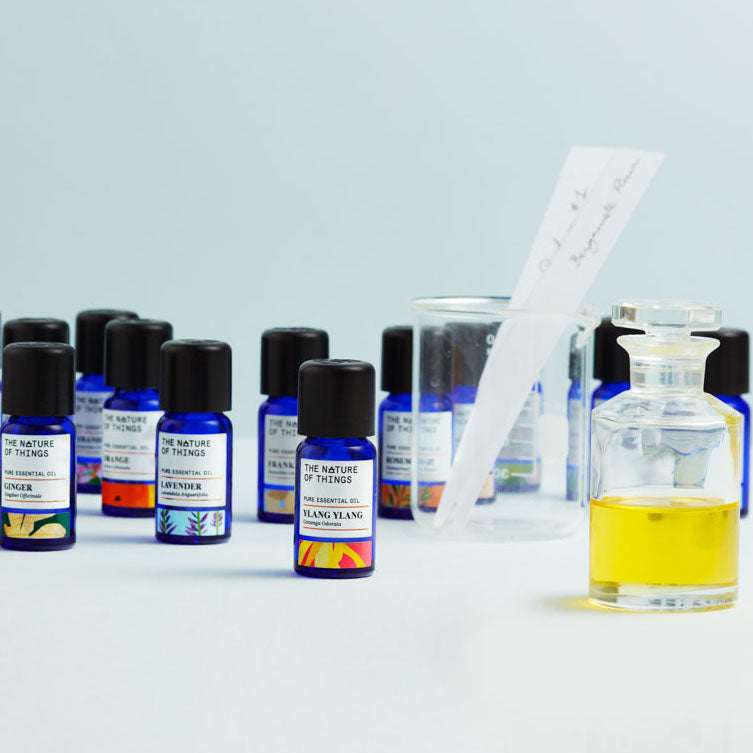Here are some tips to start blending your oils and create your base for a perfume, scrub, massage oil or any other natural beauty or wellness recipe.
Remember that whatever the purpose, it is best to create the blend of essential oils separately so you can 1) take the time to work on the right formula and 2) let it mature/blend before it is mixed to your final product.
Here are the steps I recommend for a beginner:
1. Gather your oils
- Think about your final product/recipe and what you want to achieve. Are you using the oils to for their positive benefits on health and wellness or do you just want to create a nice smelling scent for your diffuser, perfume, massage oil, etc.
- If for wellness purposes, your collection of oils will be mostly reduced to the ones that are targeting a particular benefit. You will likely play with no more than 3-4 oils if that is the case. You can refer to our blog post on the properties of essential oils to learn about the benefits of each oil on the body or the mind.
- For creating a nice smelling scent, you can display your entire collection of oils, it doesn't matter if it is 5, 10 or 20. What you need to do there is to start thinking of a general olfactive (scent) direction. Do you want something fruity? floral? herbaceous? fresh and citrusy? And if you are not sure that’s OK, you will start making up your mind in step 4.
2. Get your tools & accessories
- a piece of paper and a pen to make notes of what you are smelling and mixing.
- a small empty bottle
- a small and precise scale if you want to measure by weight (as opposed to drops) and something to stir/mix the oils.
- Pipettes if your oils don't have droppers
3. Smell the ingredients selected in your palette one by one
It’s a good exercise to regularly remind yourself of the quality of each oil and it will help you decide on the olfactive direction you want to take. You can for instant associate the oils by family: the citruses, the fruits, the aromatic herbs, the woods, etc. Take a look at our blog post on olfactive families for inspiration
4. Now let's start blending, this is where the fun begins
Several approaches and methods were developed over the past century and one that I feel is well adapted to a beginner is the Jean Carles method (French Perfumer) of which I have distilled and adapted here the basic principles:
- Find the right balance
Pick the two materials that you feel will be at the core of your formula. Put 1 drop of each in your glass container and if you have, dip a smelling strip. If you feel it smells too much of one oil vs the other and is somewhat unbalanced, start adding a drop of the weaker oil and smell again. Repeat until you find the right balance between the two oils and make sure you reach a total of 10 drops total. For instance 3 drops of geranium and 7 drops of lavender.
1:1 = 5:5 -- if it smells right 5x each side2:3 = 4:6 -- if it smells right double both sides
2:5 ~ 3:7 -- if it smells right you can simply add 1 and 2 to actually make it 3:7
4:16 = 2:8 -- will give you more than 10 units
4:36 = 1:9 -- will give you more than 10 units
1:4 = 2:8 -- if it smells right double both sides
1:9 = 1:9 -- if it smells right you are already at 10 units
- Start building on your core blend
Now that you are happy with your core blend of 2 oils, you can start building on it to add some complexity or refinement to your scent.
You can for instance decide to add a new olfactory facet, like adding some wood to a fruity/floral core blend. Or you can decide to strengthen a particular facet, adding for instance some orange to a core that contains another citrus like bergamot for instance. Whatever the direction, use the following approach:
1:10 = add 1 drop of the new oil to your core blend of 10 drops.
Take the time to blend well and let mature/sit for a few minutes before smelling. Repeat that at each step.
2:10 = add another drop to the total. Remember that this new note should be subtle and complement your core.
As soon as you are happy, stop and repeat the same with another oil.
If you are happy with your fragrance with four oils, just stop there. You don't want to have more than 4-5 oils total as a start and you can make an excellent scent with these 5 oils, remember it's all about balance.
And more important, have fun with it!


1 comment
This is a really helpful article! Thank you so much for sharing :-)